|
– V I
E T N A M –
August 2, 2004 – Greetings
from the East China Sea. We left Keelung,
Taiwan, last night at the conclusion of a four-day visit. We are now
heading to Kobe, Japan, where we expect
to dock at 8:00am on August 4. Due to an unexpected glitch in the
ship's
internet
service my earlier upload of the Hong Kong photo album failed. It
is now back
online. Please click
here if you would
like to see it.
Vietnam
This week I will tell you about our Vietnam experience.
We arrived in Vietnam on July 21 and anchored in the Gulf
of
Tonkin's
Ha Long
Bay, which is located in the northeast corner of the country, approximately
100
miles
east
of Hanoi
and 100 miles southwest of the Chinese border. The bay
is one of Vietnam's most impressive natural wonders. It is said
to be
the most scenic
undeveloped port in the 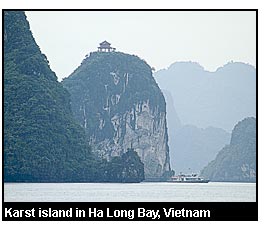 world
due to its sparkling blue water dotted with thousands of
steep islands which rise up dramatically from
the sea floor. These large island-towers
of craggy
rock are in fact karst formations
comprised of limestone that has evolved and weathered for
over 20 million years. Ha Long Bay covers 1500 square meters and contains
approximately 3000 karst islands, many of which contain large grottoes
just beckoning to be explored. In 1994 UNESCO named Ha Long Bay a
"World Heritage Site" in recognition of its profoundly
beautiful
maritime karst landscape that is truly unique
in all the world. Adding to the mystique of the exotic landscape are
hundreds of fishing and passenger "junks" of various sizes, color,
and condition that crisscross the bay. (Ha Long Bay's name
means "Bay of Descending Dragons." ) world
due to its sparkling blue water dotted with thousands of
steep islands which rise up dramatically from
the sea floor. These large island-towers
of craggy
rock are in fact karst formations
comprised of limestone that has evolved and weathered for
over 20 million years. Ha Long Bay covers 1500 square meters and contains
approximately 3000 karst islands, many of which contain large grottoes
just beckoning to be explored. In 1994 UNESCO named Ha Long Bay a
"World Heritage Site" in recognition of its profoundly
beautiful
maritime karst landscape that is truly unique
in all the world. Adding to the mystique of the exotic landscape are
hundreds of fishing and passenger "junks" of various sizes, color,
and condition that crisscross the bay. (Ha Long Bay's name
means "Bay of Descending Dragons." )
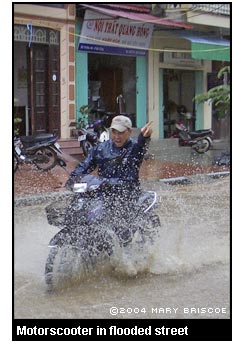 Ha Long City Ha Long City
The
Explorer anchored offshore from Ha Long City, a small bustling community
that derives much of its income from the tourist trade and fishing.
Most Ha Long's tourists are vacationing VIetnamese, but cruise
ships sometimes appear with Japanese visitors or, less
frequently, Europeans. We spent our first day in Vietnam
exploring the streets until we were chased into a small restaurant
by a torrent of rain. The restaurant itself was protected on three
sides by solid walls, while the fourth side was completely open to
the street. From the relative comfort of a small table and four lopsided
chairs, a group of us passed the time drinking
beer and eating
Saigon
spring rolls, crab fried noodles, and garlic fried prawns
while we watched a portion of Ha Long City's resident population
slog by as they went about their business. Most of them were getting
completely soaked. The reason for all that rain can be summed up in
one word: MONSOON. The summer monsoon had arrived Vietnam just a week
earlier, bringing with
it
a change
in the prevailing wind patterns and lots of moisture.
Rural Vietnam
We saw more evidence of the
heavy monsoon rains the next day when we climbed onto a motorcoach
(bus) with ten students and our Vietnamese guide for a three day field
trip
which
began with a three and a half hour bus trip to Hanoi. It had been
raining
most
of the
night.
It was raining
when we got on the bus. It would continue to
rain for almost three full days. It was also very hot.
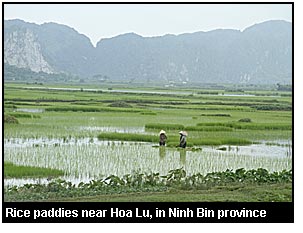 As
soon as we left Ha Long City, the surrounding landscape became a broad
checkerboard of modulated
green squares and rectangles – rice
paddies under various states of cultivation. Vietnam is the world's
third largest exporter of rice. (Number one is Thailand and number
two is the United States. Vietnam's rice generally ships to Africa
because the rice is of inferior quality and Africa provides a strong
market for cheap grades of rice.) The rice paddies we saw on the way
to Hanoi were tended almost exclusively by woman. Even from a distance
we could tell the laborers were woman, not men, because they all wore
distinctive
conical
hats. (Vietnamese men do not wear such hats.) According
to
our guide,
80% of Vietnam's workforce consists of farmers living in small farming
villages of 500 to 10,000 people with each family tending up to three
plots of land. As
soon as we left Ha Long City, the surrounding landscape became a broad
checkerboard of modulated
green squares and rectangles – rice
paddies under various states of cultivation. Vietnam is the world's
third largest exporter of rice. (Number one is Thailand and number
two is the United States. Vietnam's rice generally ships to Africa
because the rice is of inferior quality and Africa provides a strong
market for cheap grades of rice.) The rice paddies we saw on the way
to Hanoi were tended almost exclusively by woman. Even from a distance
we could tell the laborers were woman, not men, because they all wore
distinctive
conical
hats. (Vietnamese men do not wear such hats.) According
to
our guide,
80% of Vietnam's workforce consists of farmers living in small farming
villages of 500 to 10,000 people with each family tending up to three
plots of land.  Vietnam's
Communist government, which gained full control of
Vietnam
in 1975, owns the land but families are granted exclusive rights
to farm it. By most accounts, Vietnamese woman work harder than
Vietnamese men, and in many ways they are the backbone of society.
Although they
have
few fundamental rights and must defer to their husbands, it's the
women who are responsible for most of the field labor while at the
same
time
looking
after their
own homes
and
families.
(The family remains the key social unit in Vietnam.) It is a hard
life, especially when the monsoon rains overwhelm the rice fields.
On our trip to Hanoi we saw countless flooded fields. Our guide told
us that when the rice plants are completely covered with water, as
so much of them were, the plants
will die because they cannot breathe. As soon as the water subsides
the fields must be replanted. Not only is this backbreaking work – everything
is done without the
aid of machinery – but there is no guarantee of a decent crop
because the replacement crop may not have enough time to mature. Vietnam's
Communist government, which gained full control of
Vietnam
in 1975, owns the land but families are granted exclusive rights
to farm it. By most accounts, Vietnamese woman work harder than
Vietnamese men, and in many ways they are the backbone of society.
Although they
have
few fundamental rights and must defer to their husbands, it's the
women who are responsible for most of the field labor while at the
same
time
looking
after their
own homes
and
families.
(The family remains the key social unit in Vietnam.) It is a hard
life, especially when the monsoon rains overwhelm the rice fields.
On our trip to Hanoi we saw countless flooded fields. Our guide told
us that when the rice plants are completely covered with water, as
so much of them were, the plants
will die because they cannot breathe. As soon as the water subsides
the fields must be replanted. Not only is this backbreaking work – everything
is done without the
aid of machinery – but there is no guarantee of a decent crop
because the replacement crop may not have enough time to mature.
Hanoi
We reached Hanoi in time
to dine at a very nice restaurant. We then spent most of the afternoon
touring the
Ho Chi Minh Relic Area. President Ho Chi Minh
(1890-1960) is affectionately known as "Uncle Ho" throughout Vietnam.
They refer to the Vietnam War, meaning the US-led Vietnam War
that ended in 1975, as The American War, because that is essentially
what
it was. While many Americans still have painful memories of that era
(myself included) the Vietnamese people have clearly moved on. Indeed,
85% of Vietnam's population is under the age of forty. To them,
the war is long past. They are busy living their lives and harbor
no ill-will toward Americans. 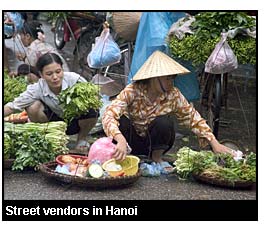 Everyone we met in Vietnam appeared
friendly and relaxed. The only tension I detected surrounded the
topic of China.
Relations between China and Vietnam are very strained. Our guide told
us that China wants to dominate and control Vietnam's economy and
through clever,
underhanded means it is doing everything possible to achieve this
end. How true this is I cannot
say, but we heard some
interesting stories. Everyone we met in Vietnam appeared
friendly and relaxed. The only tension I detected surrounded the
topic of China.
Relations between China and Vietnam are very strained. Our guide told
us that China wants to dominate and control Vietnam's economy and
through clever,
underhanded means it is doing everything possible to achieve this
end. How true this is I cannot
say, but we heard some
interesting stories.
After visiting "Uncle Ho's
House" we continued on to other spots of interest, including the very
beautiful Temple of Literature (Van Mieu), which was built by King
Ly Thanh Tong in 1070 to honor the founder of Confucianism. We passed
the infamous yellow prison known as the "Hanoi Hilton" but
we did not have a chance to go
inside. We then spent an hour wandering along an extensive Hanoi
street market. We ended the day by attending an evening performance
at the
Thang Long Water Puppet Theatre.
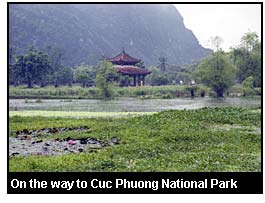 Moving On Moving On
By the next morning
I was so sick that I almost took a taxi back to the ship (a
three-plus hour trip!) because I
was didn't think I could continue traveling.
Since Hong Kong I had been fighting something we jokingly call "Ship-SARS,"
a highly
contagious
virus that has hammered much of the shipboard population over
the past month or so. I was running a fever and after several nights
of major sleep deprivation due to heavy coughing, I was almost
in
tears.
My husband
and
the guide persuaded me to stick with the program, which meant climbing
back onto the bus for a four hour drive into the jungles of northern
Vietnam. Our destination was Cuc Phuong National Park, a 62,000 acre
nature preserve located 140 kilometers south of Hanoi. We were
to spend
the night in
Cuc
Phuong at a rustic longhouse (lodge). The next morning we would trek
in the jungle. Oh boy!
Previous
Installment || Last Week's Photo Gallery ||
Next Installment
Archived comments (3) |
©2002-2008
by Ginnie Saunders. All rights are reserved. No part of this web
site
may be reproduced or transmitted in any form or by any means —
electronic or mechanical, including photocopying, recording, or by
any information storage or retrieval system — without written
permission from Ginnie
Saunders. To learn more about copyright issues on the web,
visit the Web Law
FAQ.
Ginnie.com, Inc.
PO Box 50314
Columbia, SC 29250
(803) 783-3169
www.ginnie.com
|


|

![]()



 world
due to its sparkling blue water dotted with thousands of
steep islands which rise up dramatically from
the sea floor. These large island-towers
of craggy
rock are in fact karst formations
comprised of limestone that has evolved and weathered for
over 20 million years. Ha Long Bay covers 1500 square meters and contains
approximately 3000 karst islands, many of which contain large grottoes
just beckoning to be explored. In 1994 UNESCO named Ha Long Bay a
"World Heritage Site" in recognition of its profoundly
beautiful
maritime karst landscape that is truly unique
in all the world. Adding to the mystique of the exotic landscape are
hundreds of fishing and passenger "junks" of various sizes, color,
and condition that crisscross the bay. (Ha Long Bay's name
means "Bay of Descending Dragons." )
world
due to its sparkling blue water dotted with thousands of
steep islands which rise up dramatically from
the sea floor. These large island-towers
of craggy
rock are in fact karst formations
comprised of limestone that has evolved and weathered for
over 20 million years. Ha Long Bay covers 1500 square meters and contains
approximately 3000 karst islands, many of which contain large grottoes
just beckoning to be explored. In 1994 UNESCO named Ha Long Bay a
"World Heritage Site" in recognition of its profoundly
beautiful
maritime karst landscape that is truly unique
in all the world. Adding to the mystique of the exotic landscape are
hundreds of fishing and passenger "junks" of various sizes, color,
and condition that crisscross the bay. (Ha Long Bay's name
means "Bay of Descending Dragons." ) Ha Long City
Ha Long City As
soon as we left Ha Long City, the surrounding landscape became a broad
checkerboard of modulated
green squares and rectangles – rice
paddies under various states of cultivation. Vietnam is the world's
third largest exporter of rice. (Number one is Thailand and number
two is the United States. Vietnam's rice generally ships to Africa
because the rice is of inferior quality and Africa provides a strong
market for cheap grades of rice.) The rice paddies we saw on the way
to Hanoi were tended almost exclusively by woman. Even from a distance
we could tell the laborers were woman, not men, because they all wore
distinctive
conical
hats. (Vietnamese men do not wear such hats.) According
to
our guide,
80% of Vietnam's workforce consists of farmers living in small farming
villages of 500 to 10,000 people with each family tending up to three
plots of land.
As
soon as we left Ha Long City, the surrounding landscape became a broad
checkerboard of modulated
green squares and rectangles – rice
paddies under various states of cultivation. Vietnam is the world's
third largest exporter of rice. (Number one is Thailand and number
two is the United States. Vietnam's rice generally ships to Africa
because the rice is of inferior quality and Africa provides a strong
market for cheap grades of rice.) The rice paddies we saw on the way
to Hanoi were tended almost exclusively by woman. Even from a distance
we could tell the laborers were woman, not men, because they all wore
distinctive
conical
hats. (Vietnamese men do not wear such hats.) According
to
our guide,
80% of Vietnam's workforce consists of farmers living in small farming
villages of 500 to 10,000 people with each family tending up to three
plots of land.  Vietnam's
Communist government, which gained full control of
Vietnam
in 1975, owns the land but families are granted exclusive rights
to farm it. By most accounts, Vietnamese woman work harder than
Vietnamese men, and in many ways they are the backbone of society.
Although they
have
few fundamental rights and must defer to their husbands, it's the
women who are responsible for most of the field labor while at the
same
time
looking
after their
own homes
and
families.
(The family remains the key social unit in Vietnam.) It is a hard
life, especially when the monsoon rains overwhelm the rice fields.
On our trip to Hanoi we saw countless flooded fields. Our guide told
us that when the rice plants are completely covered with water, as
so much of them were, the plants
will die because they cannot breathe. As soon as the water subsides
the fields must be replanted. Not only is this backbreaking work – everything
is done without the
aid of machinery – but there is no guarantee of a decent crop
because the replacement crop may not have enough time to mature.
Vietnam's
Communist government, which gained full control of
Vietnam
in 1975, owns the land but families are granted exclusive rights
to farm it. By most accounts, Vietnamese woman work harder than
Vietnamese men, and in many ways they are the backbone of society.
Although they
have
few fundamental rights and must defer to their husbands, it's the
women who are responsible for most of the field labor while at the
same
time
looking
after their
own homes
and
families.
(The family remains the key social unit in Vietnam.) It is a hard
life, especially when the monsoon rains overwhelm the rice fields.
On our trip to Hanoi we saw countless flooded fields. Our guide told
us that when the rice plants are completely covered with water, as
so much of them were, the plants
will die because they cannot breathe. As soon as the water subsides
the fields must be replanted. Not only is this backbreaking work – everything
is done without the
aid of machinery – but there is no guarantee of a decent crop
because the replacement crop may not have enough time to mature. Everyone we met in Vietnam appeared
friendly and relaxed. The only tension I detected surrounded the
topic of China.
Relations between China and Vietnam are very strained. Our guide told
us that China wants to dominate and control Vietnam's economy and
through clever,
underhanded means it is doing everything possible to achieve this
end. How true this is I cannot
say, but we heard some
interesting stories.
Everyone we met in Vietnam appeared
friendly and relaxed. The only tension I detected surrounded the
topic of China.
Relations between China and Vietnam are very strained. Our guide told
us that China wants to dominate and control Vietnam's economy and
through clever,
underhanded means it is doing everything possible to achieve this
end. How true this is I cannot
say, but we heard some
interesting stories. Moving On
Moving On